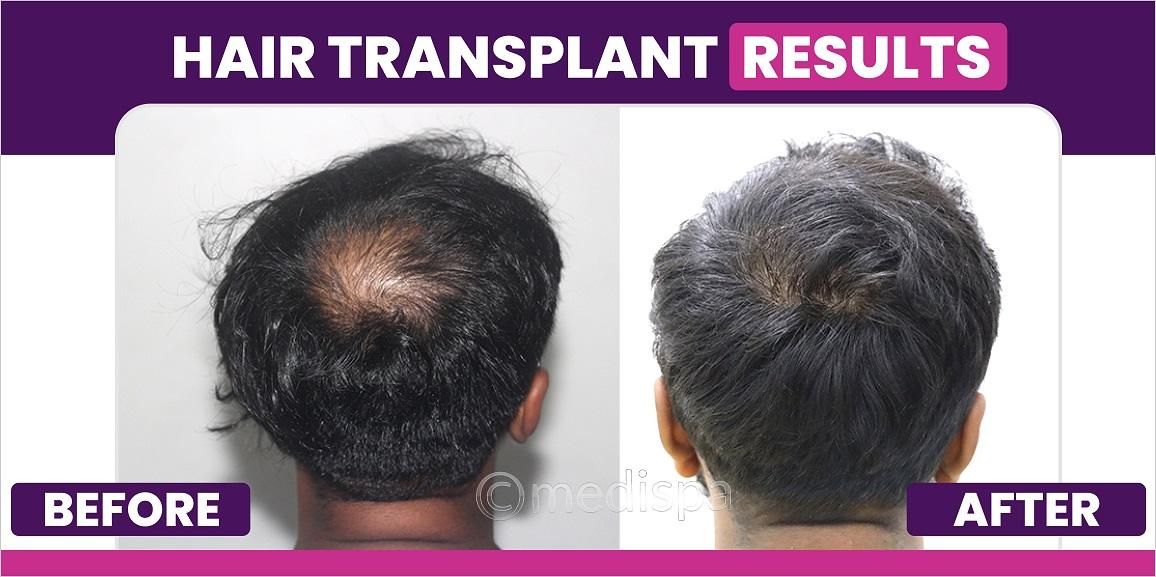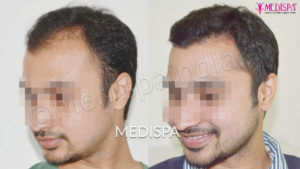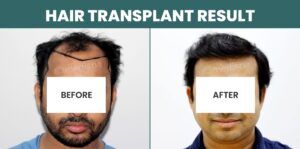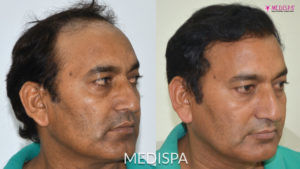
Over the past few decades, the city has witnessed significant urban growth alongside anexpanding medical infrastructure. It has emerged as one of India’s premier destinations for hair transplant procedures. The reputation of hair transplant in Delhi has been bolstered by the presence of numerous high-quality clinics. Among these, the Medispa Hair Transplant Clinic stands out, led by Dr. Suneet Soni, a highly regarded hair transplant surgeon in India. Under Dr. Soni’s expertise, Medispa Hair Transplant has successfully managed over 10,000 cases, including many complex situations. Additionally, we provide competitively priced hair transplant services in Delhi.
Hair transplant
Hair grafts are extracted from the donor region, where permanent hair follicles are situated, and subsequently implanted into the designated bald area through a minimally invasive surgical technique referred to as a hair transplant. It is advisable to take ample time in planning and selecting a reputable hair transplant surgeon to ensure optimal results, as this procedure is elective and not an urgent necessity. The procedure is feasible only when there is sufficient hair density in the donor area to provide adequate coverage, utilizing exclusively your own hair. The two primary techniques employed in hair transplantation are Follicular Unit Extraction (FUE) and Follicular Unit Transplantation (FUT), which differ in their methods of graft harvesting.
Steps of hair transplant procedure
The hair transplant procedure is highly regarded among individuals experiencing hair loss. Increasingly, people are opting for this method to tackle facial hair loss as well. The procedure itself is relatively straightforward; however, it demands a high level of precision. To achieve optimal results, a comprehensive planning phase is essential. Prior to making the most suitable hair transplant recommendation, the physician should conduct a detailed assessment.
To perform a hair transplant, it is necessary to first extract hair follicles from the donor area and subsequently implant them into the balding region. The donor area is characterized by the presence of permanent hair follicles. Common sites for harvesting these follicles include the back and sides of the head, the chest, the underarms, or the beard. The successful implantation of these permanent hair follicles ensures lasting results following the hair transplant.
Hair transplant options and their benefits
The two primary techniques for hair transplantation are FUE and FUT.
FUT hair transplant involves the excision of a strip of skin from the sides and back of the scalp. This strip is then sent to a laboratory, where individual hair follicles are meticulously extracted under a microscope. The donor area is subsequently closed with sutures, while the extracted hair roots are implanted into the balding regions.
Advantages:
- This method allows for the transplantation of a greater number of hair follicles, typically ranging from 3,000 to 3,500.
- Due to the higher follicle count, it is capable of addressing larger areas of baldness in a single procedure.
- The extraction is confined to a smaller area, thereby preserving the donor site for future procedures.
- The use of a microscope minimizes damage to the hair follicles during extraction.
- This technique can be performed without the need for shaving the donor area.
FUE hair transplant, on the other hand, involves the individual extraction of hair follicles from the donor site using a specialized punch tool. This instrument gently removes each follicle, which is then implanted into the balding areas.
Advantages:
- This technique typically yields between 2,000 and 2,500 hair follicles.
- It is suitable for addressing early stages of hair loss as well as for facial hair transplants.
- The procedure can be conducted in clinics with basic facilities.
For further information regarding hair loss treatment options, consider visiting a medispa center in Delhi or Jaipur.
The combination technique of FUT and FUE employs both methods to achieve optimal results. This approach is effective for patients experiencing varying degrees of baldness, making it a preferred choice among many surgeons worldwide, provided the patient is a suitable candidate.
The benefits of this combined technique include:
- The preservation of donor hair for potential future use, particularly through the FUE method.
FUE hair transplant:
This method generally produces between 2,000 and 2,500 hair follicles. It is appropriate for treating the initial phases of hair loss as well as for facial hair transplantation. The procedure can be performed in clinics equipped with basic amenities.
For additional details on hair loss treatment alternatives, you may wish to explore a medispa center located in Delhi or Jaipur.
The combined technique of FUT and FUE utilizes both procedures to attain the best possible outcomes. This strategy is particularly effective for patients with varying levels of baldness, making it a favored option among numerous surgeons globally, assuming the patient meets the necessary criteria. The advantages of this hybrid technique include the preservation of donor hair for possible future applications, especially through the FUE method.
Combination technique of FUT and FUE:
Both the FUT and FUE techniques are employed in this procedure. Achieving a full head of hair is attainable through this method, applicable to both mild and severe baldness. Consequently, this approach has become the preferred choice for numerous surgeons worldwide, provided the patient is suitable for the procedure. There are several advantages to obtaining a denser head of hair using this technique, which include:
- The capacity to preserve donor hair for potential future applications: The FUE method allows for the extraction of 2000 to 2500 grafts in a single session; additional harvesting sessions are not advisable as they may lead to overharvesting and compromise the safe donor area. An added benefit of this combined technique is that even if we obtain over 4000 grafts, we can still maintain the integrity of the donor region for future hair transplant interventions, should they be required in cases of significant baldness and ongoing hair loss.
- Safe donor regions should be utilized judiciously: Exceeding 2500 grafts during the FUE procedure may compromise the safe donor area and yield only temporary results. However, by employing a combined approach, the integrity of the safe zone can be preserved while extracting additional grafts through both FUT and FUE techniques independently.
- Ensures optimal coverage of bald areas: FUE is typically recommended for initial baldness cases and facial hair transplants, as it is not effective in covering extensive bald areas when used in isolation. By implementing combination strategies, it is possible to achieve maximum coverage without diminishing the density of the safe donor area, thereby allowing for the extraction of a larger number of grafts.
- Facilitates more natural results: The FUE method alone has a limited capacity for harvesting individual grafts suitable for implantation in the frontal hairline and temporal regions, which are essential for achieving a natural appearance. In contrast, the FUT technique allows for high-magnification graft separation, making it easier to isolate these single grafts. Consequently, when a combined technique is employed, the highest quality single grafts obtained through FUT are strategically placed at the hairline and temporal areas for a more natural look, while the numerous grafts harvested via FUE are positioned below the hairline to enhance fullness.
- Minimizes graft damage: The FUE technique, which involves extracting each graft with a punch, is associated with a higher rate of graft damage. In contrast, the combination method primarily utilizes FUT for graft harvesting, which boasts a significantly lower damage rate of approximately 1%, thereby optimizing graft yield.
- Allows for future multiple sessions: The combination technique enables the possibility of conducting 2-3 additional sessions of FUE after the initial procedure, facilitating future hair restoration efforts.






